Plot summary
Derec, who has amnesia, and Katherine have been transported to mysterious planet containing an experimental city entirely populated by robots. The only other human that had resided in the city was murdered several days before their arrival, which was by transport using a mysterious device called the Key of Perihelion. Because they wish to keep secret how they arrived in Robot City, the robots assume either Derec or Katherine committed the murder. Of course, a robot could not do so due to the First Law. Thus, Derec and Katherine must clear their names.
Meanwhile, the city is growing and changed at an alarming rate. Buildings literally change right before their eyes. Derec learns the material the robots and the city itself is made of is the same highly advanced material that the robots of the asteroid he woke up on were made of, therefore connecting the two. The city is also plagued with nightly thunderstorms which produce a tremendous amount of rain. The city's reservoir is about to overflow, which would destroy the city.
While investigating the murder, they find a room at the top of the Compass Tower, the building on which they appeared when using the Key. The room is clearly used by the creator of Robot City to watch over the city without interfering or even being noticed by the rest of the city. While searching the Central Core's data with a security-free computer terminal in the room Derec secretly learns Katherine's name is an assumed name and is angered at her deceit. He also learns that the Central Core refers to him as David 1 while referring to the dead man as David 2, adding to his theory that none of his experiences since he woke up are merely coincidence.
Derec begins to believe the death of David, the rain, and the city's grown are interconnected. Derec and Katherine decide to split up to speed up their investigations. Derec learns that the mining of building material is causing tremendous amounts of dust and that the building and changing of the city is creating tremendous amounts of heat and water vapor. Together, they are causing the rains, which will soon destroy the city. However, the city has perceived an alien presence and is in a heightened security mode, which is the cause of the rapid growth of the city. Since the presence was registered by the Central Core at the time David was murdered, they must solve the murder and convince it there is no alien presence to get the city to shut down, thus saving it.
Katherine finds the body of David still in the enclosed room formed when he died and has a utility robot cut a hole into it. She goes in to find that David looks exactly like Derec and faints. When she wakes back in their quarters she complains of a headache, but is willing to return to the body's location with Derec. When they arrive it has been removed, assumingly by the clean up robots, and the room is empty. Derec theorizes it was pathogens in human blood (from a mundane cut on David's shoeless foot) that the Central Core was interpreting as an alien presence because of its lack of data on normal human blood borne pathogens. To test it, he cuts himself on the jagged edge of the hole in the wall and lets the blood drip on the floor. As expected, the wall responds and seals them in as it did David.
While they wait to be cut out, Katherine explains her real name is Ariel and she is the daughter of a wealthy family from Aurora. Her mother was funding the research of a Dr. Avery and this city is most likely his experiment. Also, she has an incurable disease (contracted from a spacer) and was disowned by her family and banished from the planet. She was searching for a cure when she met Derec in passing (she had earlier revealed to Derec his real name is David). Later, she was captured by Aranimass. No explanation is given to why she lied about her identity or kept this knowledge secret.
The robots arrive and begin cutting them out. Derec quickly realizes the cutting process is releasing the carbon monoxide in the building material and stops the cutting. He explains the murder wasn't really a murder and that David had died of carbon monoxide poisoning from being cut out when he was trapped. Also, Katherine's headache was also caused by the carbon monoxide when the hole was cut for her to see the body. The robots realize this and agree Derec and Katherine, now Ariel, are innocent. Derec rushes off to tell the Central Core about pathogens to stop the out of control growth and, upset at her conversation with Derec, Ariel rushes to the Compass Tower to retrieve the Key.
As the rain starts falling, Ariel climbs down from the top to where Derec hid the Key only to find it gone. A robot climbs up from the bottom to protect her from falling and the rain by clamping itself to the structure around her. Meanwhile, Derec helps the robots figure out a way to divert that night's rain runoff so it won't destroy the city. The next morning he informs the Central Core about the pathogens and the city drops its security level, thus stopping the cycle of rain-causing dust and heat. Ariel recovers from her night in the rain and tells Derec that the Key is missing. Without the Key, Derec and Ariel are stranded in Robot City with no hope of rescue.

I, Robot is a fixup novel of science fiction short stories or essays by American writer Isaac Asimov. The stories originally appeared in the American magazines Super Science Stories and Astounding Science Fiction between 1940 and 1950 and were then compiled into a book for stand-alone publication by Gnome Press in 1950, in an initial edition of 5,000 copies. The stories are woven together by a framing narrative in which the fictional Dr. Susan Calvin tells each story to a reporter in the 21st century. Although the stories can be read separately, they share a theme of the interaction of humans, robots, and morality, and when combined they tell a larger story of Asimov's fictional history of robotics.
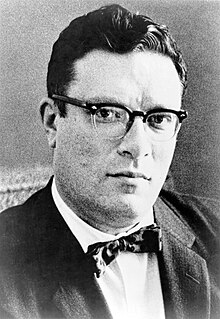
Isaac Asimov was an American writer and professor of biochemistry at Boston University. During his lifetime, Asimov was considered one of the "Big Three" science fiction writers, along with Robert A. Heinlein and Arthur C. Clarke. A prolific writer, he wrote or edited more than 500 books. He also wrote an estimated 90,000 letters and postcards. Best known for his hard science fiction, Asimov also wrote mysteries and fantasy, as well as much nonfiction.
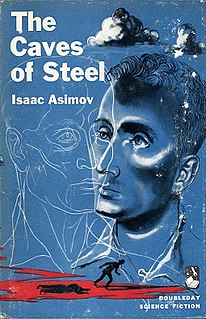
The Caves of Steel is a science fiction novel by American writer Isaac Asimov. It is a detective story and illustrates an idea Asimov advocated, that science fiction can be applied to any literary genre, rather than just being a limited genre in itself.

The Three Laws of Robotics are a set of rules devised by science fiction author Isaac Asimov. The rules were introduced in his 1942 short story "Runaround", although they had been foreshadowed in some earlier stories. The Three Laws, quoted from the "Handbook of Robotics, 56th Edition, 2058 A.D.", are:
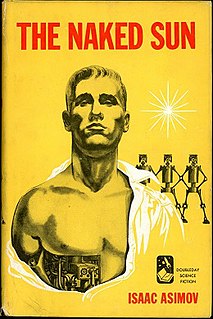
R. Daneel Olivaw is a fictional robot created by Isaac Asimov. The "R" initial in his name stands for "Robot," a naming convention in Asimov's future society during Earth's early period of space colonization. Daneel is introduced in The Caves of Steel, a serialized story published in Galaxy magazine vol. 7 #1-3 from October to December 1953. The full story was published by Doubleday as a hardcover book in 1954.

Isaac Asimov's Caliban (1993) is a science fiction novel by American writer Roger MacBride Allen, set in Isaac Asimov's Robot / Empire / Foundation universe.
"Robbie" is a science fiction short story by American writer Isaac Asimov. It was his first robot story and writing commenced on June 10, 1939. It was first published in the September 1940 issue Super Science Stories magazine as "Strange Playfellow", a title that was chosen by editor Frederik Pohl and described as "distasteful" by Asimov. A revised version of "Robbie" was reprinted under Asimov's original title in the collections I, Robot (1950), The Complete Robot (1982), and Robot Visions (1990). "Robbie" was the fourteenth story written by Asimov, and the ninth to be published. The story is also part of Asimov's Robot series, and was the first of Asimov's positronic robot stories to see publication.

Dr. Susan Calvin is a fictional character appearing in Isaac Asimov's Robot series of science fiction short stories. According to I, Robot, Susan Calvin was born in the year 1982 and died at the age of 82, either in 2064 or 2065.

I, Robot is a 2004 American science fiction action film directed by Alex Proyas. The screenplay by Jeff Vintar and Akiva Goldsman is from a screen story by Vintar, based on his original screenplay Hardwired, and named after Isaac Asimov's 1950 short-story collection. The film stars Will Smith in the main role, Bridget Moynahan, Bruce Greenwood, James Cromwell, Chi McBride, and Alan Tudyk. In 2035, highly intelligent robots fill public service positions throughout the dystopian world, operating under three rules to keep humans safe. Detective Del Spooner (Smith) investigates the alleged suicide of U.S. Robotics founder Alfred Lanning (Cromwell) and believes that a human-like robot called Sonny (Tudyk) murdered him.
Isaac Asimov's Robot City is a series of novels written by various authors and loosely connected to Isaac Asimov's Robot series. It takes place between The Robots of Dawn and Robots and Empire. Each volume is complete in itself, but they form a continuing series. The novels were written in response to a writing challenge issued by Asimov to write a series involving the Three Laws of Robotics, which brought about a collaboration of several authors. Asimov provided outlines for stories which filled in the gap between Asimov's own robot stories and his Foundation series, explaining the disappearance of the robots prior to the establishment of the galactic empire. Isaac Asimov's Robots and Aliens followed in this series, with the same protagonists and many other characters. The common theme of all books of both series is the interaction between the characters and autonomous cities run and populated by robots. Robot City was also released as a mystery game for the PC in 1995. The player takes the role of Derec.
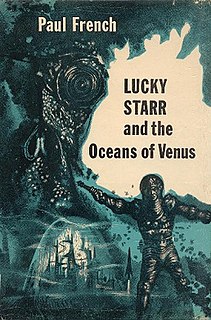
Lucky Starr and the Oceans of Venus is the third novel in the Lucky Starr series, six juvenile science fiction novels by Isaac Asimov that originally appeared under the pseudonym Paul French. The novel was first published by Doubleday & Company in 1954. Since 1972, reprints have included a foreword by Asimov explaining that advancing knowledge of conditions on Venus have rendered the novel's descriptions of that world inaccurate.
Isaac Asimov's Robots and Aliens is a series of novels written by various authors and loosely connected to Isaac Asimov's Robot series. Each volume is complete in itself, but they form a continuing series. The series follows the action of the novels of the Isaac Asimov's Robot City series, with the same protagonists Derec and Ariel, and many other characters. The plot deals with the Three Laws and encounters between robots and different varieties of alien life.
References to Isaac Asimov's Three Laws of Robotics have appeared in a wide variety of circumstances. In some cases, other authors have explored the Laws in a serious fashion. Other references, like those made in the satirical newspaper The Onion, are clearly parodic.

Isaac Asimov's Robot City: Odyssey is a science fiction novel written in 1987 by Michael P. Kube-McDowell. It is part of the series Isaac Asimov's Robot City, inspired by Isaac Asimov's Robot series. The 1995 computer game Robot City is based on the plot of Odyssey.
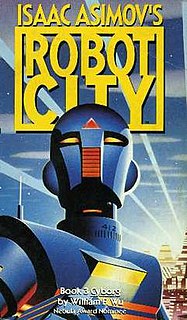
Isaac Asimov's Robot City: Cyborg is a 1987 novel by William F. Wu. It is part of the series Isaac Asimov's Robot City, which are inspired by Isaac Asimov's Robot series, and his Foundation novels.

Isaac Asimov's Robot City: Prodigy is a book written in 1988 by Arthur Byron Cover. It is part of the series Isaac Asimov's Robot City, which are inspired by Isaac Asimov's Robot series.

Isaac Asimov's Robot City: Refuge is a book written in 1988 by Rob Chilson. It is part of the series Isaac Asimov's Robot City, which is based on Isaac Asimov's Robot series. It was Rob Chilson's return to writing at novel length after a break of over a decade.

Isaac Asimov's Robot City: Perihelion is a book written in 1988 by William F. Wu. It is part of the series Isaac Asimov's Robot City, which was inspired by Isaac Asimov's Robot series.
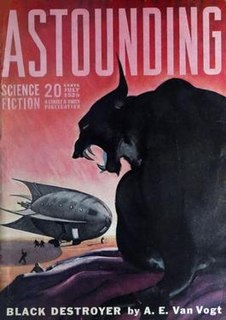
"Black Destroyer" is a science fiction short story by Canadian-American writer A. E. van Vogt, first published in Astounding SF in July 1939. It has been marked as the story that represents the start of the Golden Age of Science Fiction.















